Abstract
The Fermi surface structure of a layered organic superconductor -(BEDT-TTF)SFCHCFSO was determined by angular-dependent magnetoresistance oscillations measurements and band-structure calculations. This salt was found to have two small pockets with the same area: a deformed square hole pocket and an elliptic electron pocket. Characteristic corrugations in the field dependence of the interlayer resistance in the superconducting phase were observed at any in-plane field directions. The features were ascribed to the commensurability (CM) effect between the Josephson vortex lattice and the periodic nodal structure of the superconducting gap in the Fulde–Ferrell–Larkin–Ovchinnikov (FFLO) phase. The CM effect was observed in a similar field region for various in-plane field directions, in spite of the anisotropic nature of the Fermi surface. The results clearly showed that the FFLO phase stability is insensitive to the in-plane field directions.
1. Introduction
The discovery of superconductivity has led to breakthroughs in a wide range of fields from fundamental research and applications [1]. In particular, since the discovery of high-temperature superconducting cuprates in 1980s, the search for new superconducting mechanisms has been one of the major trends in superconductivity basic research. Among the various superconductors, organic superconductors in the vicinity of metal-insulator transitions have brought about significant progress in basic research.
Organic conductors based on BEDT-TTF molecules are characterized by a stacked structure with anion molecule (insulating) layers and BEDT-TTF molecule (conducting) layers. These conductors have attracted significant interest because of the presence of various ground states, a dimer-Mott insulating phase, a charge-ordered phase, a density wave phase, and a superconducting phase, where the degree of dimerization of the BEDT-TTF molecules, the Fermi surface instability, and the strong electron correlation play important roles. In particular, the possibility of unconventional superconductivity, mediated by antiferromagnetic spin and/or charge fluctuations, is a central concern.
When the orbital effect is suppressed and the critical field () is Pauli-limited, a unique superconducting phase, namely, the Fulde–Ferrell–Larkin–Ovchinnikov (FFLO) superconducting phase is expected to emerge at high fields [2,3]. In conventional superconductors, the spin-singlet Cooper pairs formed by up and down spins are destroyed in a magnetic field by the Zeeman effect. This pair-breaking effect gives the Pauli limit, , where is the superconducting energy gap at 0 K, and is the Bohr magneton [4]. In the FFLO phase, the Cooper pairs are formed between up and down spins on the polarized Fermi surface. Therefore, the Cooper pairs have a finite center-of-mass momentum and show a spatial modulation of the order parameter in real space; cos(), as shown in Figure 1a. As a result, the superconductivity can be stabilized even above . In recent years, experimental results suggesting its existence have been obtained in heavy fermion superconductors [5,6], oxide layered superconductors [7], ion-based superconductors [8], and organic superconductors [9,10,11,12,13,14,15,16]. In organic superconductors, the FFLO phase transition was first observed by a tuned-circuit differential susceptometer experiment for -(BEDT-TTF)Cu(NCS) [10], and, since then, various measurements [17,18,19,20,21,22,23,24] have been performed to confirm the FFLO transition.

Figure 1.
(a) Schematic illustration of the order parameter oscillation for a single case in a FFLO phase and JV lattice in a layered superconductor. The JVs are easily driven by the Lorentz force in an interlayer current I, leading to nonzero interlayer resistance even in the superconducting phase. (b) Temperature dependence of the interlayer resistance of the -SF salt. The onset of the superconducting transition can be defined as 4.8 K, consistent with the specific heat measurement [23]. Inset: crystal structure of -SF salt.
Highly two-dimensional (2D) layered superconductors can be modeled as Josephson-coupled multi-layer systems. In such superconductors, magnetic flux lines penetrating the sample can be decomposed into two parts; the pancake vortices (PVs) penetrating the superconducting layers and the Josephson vortices (JVs) penetrating the insulating layers. The JVs are pinned more loosely than the PVs, since the order parameter vanishes in the insulating layers. Therefore, the JVs are easily driven by the Lorentz force in an interlayer current, and, consequently, nonzero interlayer resistance is observed even in the superconducting phase. In the FFLO phase, periodic nodal lines of the order parameter are formed by the finite center-of-mass momentum of the Cooper pairs as depicted in Figure 1a. When the nodal lines are parallel to the JVs, they will work as pinning sites of the JVs. The wavelength of the order parameter oscillation is given by , and the JV lattice spacing is , where s is the interlayer spacing and is the flux quantum. It is expected that JVs are relatively strongly pinned by the nodal line structure for a commensurate condition (N: integer). Since is also expected to decrease with an increasing field [25,26], the commensurate condition in the FFLO phase will be periodically satisfied, leading to fine structures in the interlayer resistance curves. This commensurability (CM) effect was first predicted by Bulaevskii et al. [27]. Thus far, the CM effect has been observed in the FFLO phases for various organic superconductors, -(BETS)FeCl[15], -(BEDT-TTF)[(HO)Ga(CO)]CHNO (-Ga salt) [28], and -(BEDT-TTF)SFCHCFSO (-SF salt) [29]. Among them, the highly 2D nature of the -Ga and -SF salts with the large anion layers would provide an excellent platform for the FFLO studies, since JV dynamics play an essential role in the CM effects.
The -SF salt with 4.8 K is composed of the conducting BEDT-TTF molecular layer and the large insulating SFCHCFSO layer (inset of Figure 1b). A highly 2D electronic state has been realized, which is characterized by a large ratio of the intralayer to that of interlayer critical fields 11.5. The specific-heat measurements show strongly coupled BCS-like behavior with a full gap given by = 2.18 [30]. In a magnetic field parallel to the conducting layers, the critical field significantly exceeded the Pauli limit 10 T, above which the FFLO superconductivity is realized [31,32,33,34,35]. Optical measurements of isostructural -(BEDT-TTF)SFSO (R = CH, CHFCF, CHCF, and CHF) compounds revealed that the superconducting phase is adjacent to a charge-ordered insulating phase [36]. This could indicate superconductivity mediated by charge fluctuations, which is another reason for the interest in the salts.
In our previous studies, we clarified the FFLO phase boundary in terms of the magnetocaloric effect, torque [35], and resistance measurements [29]. We also observed the CM effect in fields almost parallel to the a-axis in the FFLO phase, above ∼9 T. The values, ranging from ∼40 nm to ∼210 nm, were obtained under the assumption of a single vector perpendicular to the field. The stability of the FFLO phase is closely related to the nesting instability of the Fermi surface, and the vector leading to a large nesting part is favorable for the FFLO phase. Therefore, the optimum vector depends on the anisotropic structure of the Fermi surface. Meanwhile, the orbital effect stabilizes the vector parallel to the field. This situation can lead to complicated field-direction dependencies of the optimum vector. Even multi--vector phases are theoretically predicted depending on the field strength and temperature [37].
In this study, we focused on the stability of the FFLO phase in the -SF salt, with an anisotropic Fermi surface. Firstly, we clarify the Fermi surface structure from the measurements of angular-dependent magnetoresistance oscillations (AMROs), and then we report the CM effect in various in-plane field directions. The CM effect was surprisingly observed in a similar field region for various in-plane field directions, despite the anisotropic Fermi surface structure. Possible scenarios for explaining these results are presented.
2. Materials and Methods
Single crystals of the -SF salt were synthesized using a standard electrochemical method [38]. Two gold wires of 10 m diameter were attached to both sides of the single crystal using carbon paste. The interlayer resistance with an electric current perpendicular to the superconducting layers was measured using a conventional four-probe AC technique. The single crystals were mounted on a two-axis rotator in a He cryostat with a 15 T superconducting magnet and cooled down to ∼0.5 K at a rate of ∼1 K/min. All measurements were performed at the Tsukuba Magnet Laboratories, NIMS.
3. Results
Figure 1b shows the temperature dependence of the interlayer resistance for the -SF salt. The resistance decreased monotonically with decreasing temperature. At ∼4.8 K, a sudden drop in resistance was observed due to the superconducting transition. Below ∼4 K, the resistance was zero within the noise level. To investigate the 2D Fermi surface structure, we first measured the AMROs in various rotation planes. Typical AMRO data are presented in Figure 2a. The angles and are defined in the inset. The characteristic dependence of the interlayer resistance is shown in the upper part of Figure 2a. In the negative second derivative curves, we can observe AMROs, which are periodic with tan(), as shown in the lower part of Figure 2a. The AMRO period directly yields the reciprocal lattice vector , values. Figure 2b shows the polar plot of obtained from the AMRO measurements at various . We can draw the cross-section of the 2D Fermi surface, inscribed in the () curves, by a solid curve, assuming an elliptical shape. The cross-section of the Fermi surface is very elongated, whose area was ∼6% of the first Brillouin zone. The AMRO results were almost consistent with those of previous reports [39].
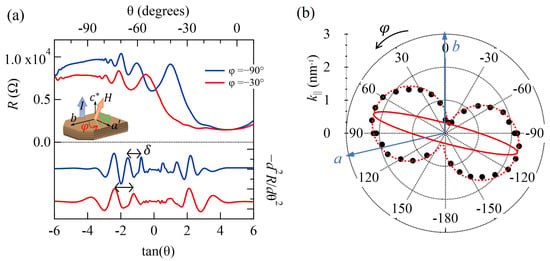
Figure 2.
(a) Typical AMRO data and their negative second derivative curves at 1.5 K for 14 T. (b) Polar plot of obtained from the AMRO measurements. The red solid curve shows the 2D Fermi surface obtained from the AMRO measurements.
In Figure 3a, we present the band calculations by an extended Huckel method [40], using lattice parameters obtained from X-ray crystallography [38]. The calculated 2D Fermi surface is depicted in Figure 3b. The results are different from the reported Fermi surface structure, with a pair of 1D Fermi surface and a closed Fermi surface [38,41], in which the Brillouin zone is apparently wrong. In our calculations, there were two pockets with different carriers: a deformed square electron pocket and an elliptic hole pocket. The areas were equal to each other, and a compensated metal was formed. This is consistent with a single frequency of the quantum oscillation [42,43,44]. For comparison, the Fermi surface obtained from the AMRO measurements is indicated by a red dotted curve, which is almost consistent with the electron pocket. In the AMRO measurements, the hole pocket was not observed. The reason for this is not clear at present.
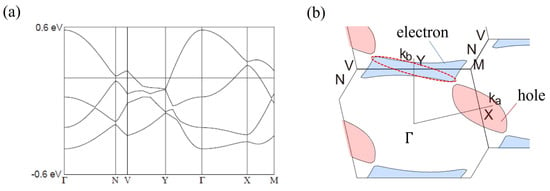
Figure 3.
(a) Band structure by an extended Huckel method and (b) 2D Fermi surface structure for the -SF salt. Deformed square hole and elliptic electron pockets were formed. The red dotted curve indicates the 2D Fermi surface determined by the AMRO measurements.
Figure 4a shows the magnetic field dependence of the interlayer resistance at various temperatures. The field was applied parallel to the b axis, in the superconducting –b plane, within the accuracy of 0.1°. At 0.5 K, the resistance increased with the field above 6.5 T, defined as . Characteristic corrugation was evident. The corrugation was reduced with increasing temperature. The critical field was determined as 13 T at 0.7 K from the specific-heat measurements [23]. The finite resistance in the wide field region below can be ascribed to the motion of the JVs in the insulating layers, as has been observed in various organic superconductors [15,28,29]. To clearly see the corrugations in detail, negative second-derivative curves of the resistance are plotted in Figure 4b. At 0.5 K, we see a broad dip at ∼6.5 T, corresponding to the resistance increase from the noise level. Above ∼8 T, we see a quasi-periodic dip structure, which is most pronounced at ∼10 T. This structure can be ascribed to the CM effect, which is observable only in the FFLO phase, as discussed in the previous reports [29]. At higher fields, the CM effect is reduced and vanishes above ∼12 T, which corresponds to the melting transition of the JV lattice. As temperature increases, the dip structure is suppressed and shifts to a lower field region. Above 2.1 K, such astructure is not evident. As has been discussed [27,29], the dips mean relatively strong pinning of the JV lattice, ascribed to the CM effect between the JV lattice and the periodic nodal structure of the gap .
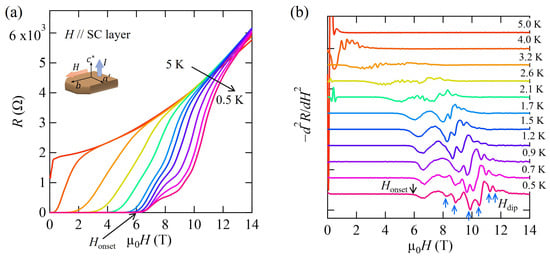
Figure 4.
(a) Magnetic field dependence of the interlayer resistance at various temperatures. The field was applied parallel to the b axis in the superconducting –b plane within an accuracy of 0.1°. (b) Negative second-derivative curves of the resistance. Each curve was shifted for clarity.
From the above results, we obtained the temperature–field phase diagram shown in Figure 5. The blue squares indicate the dip fields , and the solid curve indicates , which was determined from specific-heat measurements [23]. The FFLO phase appears in a wide region above ∼8 T and below ∼2 K. The phase diagram is very similar to that for the -axis [29], although the Fermi surface was anisotropic.
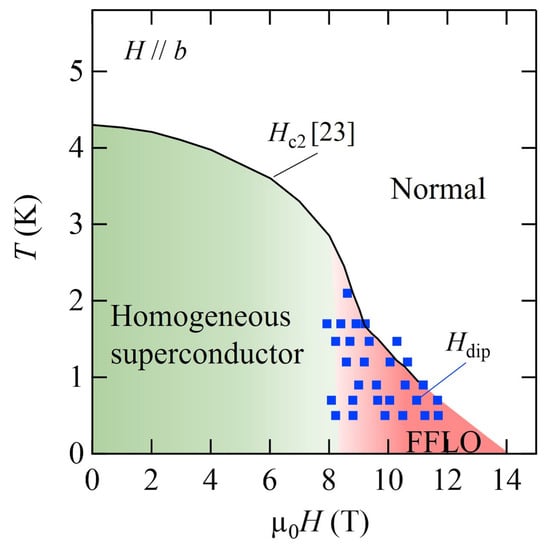
Figure 5.
Temperature–field phase diagram for axis. determined by the specific-heat measurements is indicated by a solid curve [23].
Figure 6a shows the magnetic field dependence of the resistance at various field angles . For = 0°(-axis), the resistance increased with the field above = 6 T, which is indicated by an arrow. Figure 6b shows the negative second-derivative curves of the resistance. The low value for = 0°, denoted by an arrow, indicates that only JVs were formed (no PVs), which were pinned very weakly in the insulating layers. When the field was tilted from the superconducting layer, increased. This behavior is explained by the stronger pinning of the flux lines in the superconducting layers, where PVs are formed. As the field was further tilted, was steeply reduced, leading to a decrease in . For = 0°, small dips due to the CM effect can be seen above ∼9.5 T. As the field was tilted from the layer, the CM effect was suppressed, and no CM effect was observed for 0.6°. The stability of the FFLO phase in such a small angle region is consistent with the results for the field almost parallel to the a axis [29].
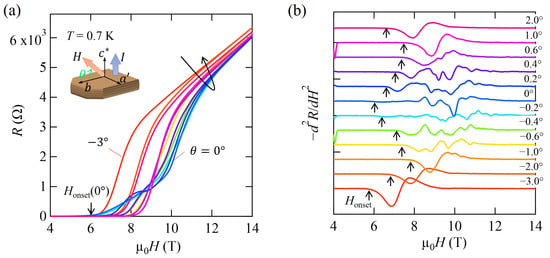
Figure 6.
(a) Magnetic field dependence of the resistance at various field angles . Definition of is in the inset. (b) Negative second-derivative curves of the resistance. Each curve is shifted for clarity.
Figure 7a shows the field dependence of the negative second-derivative curves at various in-plane field directions , as shown in the inset of Figure 7b. For = 0°, we see the onset field = 6 T (black arrow). The value had a nonmonotonic dependence. It should be noted that is the depinning field of the JV lattice [29], determined by the pinning strength at the sample edges and/or some other (impurity or defect) pinning sites, which is not related to the FFLO phase transition. The anisotropic behavior of is possibly due to the shape effect of the sample. In contrast, we observed many dips above ∼9 T, owing to the CM effect in a similar field region at any . This suggests that the FFLO phase stability was insensitive to the in-plane field direction. An important feature is that the largest dip was evident at 9 T (red arrow) in a wide-angle region, except for = 0°–45°. This dependence of the dip amplitude suggests some differences in the JV dynamics in the FFLO phase. The largest dip field corresponds to the strongest CM effect and is plotted as a function of in Figure 7b. We note that is almost isotropic, despite the anisotropic Fermi surface structure as presented in Figure 3b.

Figure 7.
(a) Magnetic field dependence of the negative second-derivative curves at various in-plane field directions defined in the inset of (b). Each curve is shifted for clarity. The onset field and the largest dip field are indicated by black and red arrows, respectively. (b) as a function of . The dotted curve indicates the expected value for the CM condition cos() with a single vector.
4. Discussion
We observed the CM effect in various in-plane field directions, which is recognized as strong evidence of the FFLO phase characterized by the vector. As pointed out, the vector leading to a large nesting part is favorable for the FFLO phase, as schematically depicted in Figure 8a, where the largest number of Cooper pairs can be formed by the vector, perpendicular to the flat part of the Fermi surface. On the other hand, in the presence of the orbital effect, the vector parallel to the field is favorable for an isotropic Fermi surface, leading to no CM effect. The observation of the CM effect at any indicates that the vector is not parallel to the field.
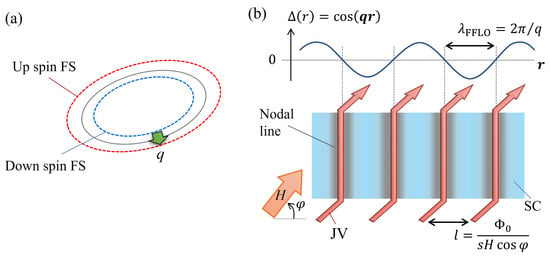
Figure 8.
(a) Spin-polarized 2D Fermi surface in a magnetic field. Up and down Fermi surfaces are indicated by red and blue curves, respectively. (b) Schematic nodal line structure of a FFLO phase and JV lattice in a tilted field for the CM condition = 1.
The largest dip at in Figure 7a suggest the strongest CM effect, = 1, where all the flux lines can fit into the nodal lines completely. Assuming that the vector is fixed to a certain direction (for instance, -axis), the JV lattice spacing is given by cos() as depicted in Figure 8b. This leads to large dependence of as indicated by the dotted curve in Figure 7b, which is inconsistent with the experimental result. This inconsistency requires another factor on the stability of the FFLO phase. At the nodal lines, the order parameter vanishes in the superconducting layers. Therefore, the most stable condition of the vortex structure will be that all the flux lines are almost parallel to the nodal lines; the vector is almost perpendicular to the field. This suggests that the direction of the vector changes with the field direction. In the anisotropic Fermi surface, the vector length should also be anisotropic, depending on the energy dispersion. Although it is difficult to know the dependence of the vector, this scenario could explain the lack of significant dependence of in Figure 7b.
Recent specific-heat measurements show that is the same at a few different in-plane field directions in a low temperature range [23]. The fact shows that the FFLO stability is independent of , and seems to be consistent with our results: no significant dependence of . Theoretically, the in-plane anisotropies of are led by Fermi surface structure and orbital effects in the FFLO phase [45]. Therefore, no in-plane anisotropy of in the specific-heat measurements suggests that the orbital effect is almost negligible, and the vector is most likely pinned to an optimal direction independent of the in-plane field direction. The inconsistency with our results remains an open question.
Another possible scenario that could explain our results is that multi- vectors [37] are formed in the -SF salt, since the two different Fermi pockets are present as shown in Figure 3b. In this case, the -dependent anisotropic stability of the FFLO phase could be smeared out; the FFLO phase may appear in a similar field range, independent of the in-plane field direction. This scenario may also explain the lack of a significant in-plane anisotropy of and .
Finally, we briefly mention the results for another FFLO superconductor -(BETS)FeCl, which had a pair of 1D and a 2D Fermi surfaces [15]. In this salt, the CM effect was first observed in the field-induced superconducting phase. The CM effect was clearly observed for but not for . The results show that a single vector was fixed to the a-axis in the whole FFLO phase. The different behavior of the CM effect between -SF salt and -(BETS)FeCl will be closely related to the Fermi surface structure. More detailed measurements of the CM effect in other FFLO superconductors will be required to clarify the correlation between the Fermi surface structure and the vector.
5. Conclusions
The AMRO measurements and band-structure calculations in the -SF salt show that the Fermi surface is composed of two small pockets, a deformed square electron pocket, and an elliptic hole pocket, which are different from the previous report. The CM effect in the interlayer resistance was observed in a similar field region at any in-plane field directions. This indicates that the stability of the FFLO phase is almost isotropic, which is consistent with the observations of precious specific-heat measurements. Two possible scenarios are proposed: (1) a single center-of-mass momentum of the Cooper pairs, which changes with the in-plane field direction, and (2) multi- vectors, originating from the two anisotropic Fermi surfaces.
Author Contributions
S.S., T.T. and S.U. designed the experiments. S.S. and S.Y. mainly performed the resistance measurements and analyzed the data. H.A. and Y.N. performed the band calculation. J.A.S. synthesized the single crystals. S.U. supervised the project. All authors have read and agreed to the published version of the manuscript.
Funding
This work was supported by KAKENHI 17H01144 and 20K14400.
Institutional Review Board Statement
Not applicable.
Informed Consent Statement
Not applicable.
Data Availability Statement
The data that support the findings of this study are available from the corresponding author on reasonable request.
Acknowledgments
Work at ANL was supported by U. Chicago Argonne, LLC, Operator of Argonne National Laboratory (“Argonne”). Argonne, a U.S. Department of Energy Office of Science labor s operated under Contract No. DE-AC02-06CH11357. J.A.S. acknowledges support from the Independent Research = Development program while serving at the National Science Foundation.
Conflicts of Interest
The authors declare no conflict of interest.
References
- Martucciello, N.; Giubileo, F.; Grimaldi, G.; Corato, V. Introduction to the focus on superconductivity for energy. Supercond. Sci. Technol. 2015, 28, 070201. [Google Scholar] [CrossRef]
- Fulde, P.; Ferrell, R.A. Superconductivity in a strong spin-exchange field. Phys. Rev. 1964, 135, A550. [Google Scholar] [CrossRef]
- Larkin, A.I.; Ovchinnikov, Y.N. Nonuniform state of superconductors. Zh. Eksp. Teor. Fiz 1964, 47, 1136. [Google Scholar]
- Clogston, A.M. Upper limit for the critical field in hard superconductors. Phys. Rev. Lett. 1962, 9, 266. [Google Scholar] [CrossRef]
- Radovan, H.A.; Fortune, N.A.; Murphy, T.P.; Hannahs, S.T.; Palm, E.C.; Tozer, S.W.; Hall, D. Magnetic enhancement of superconductivity from electron spin domains. Nature 2003, 425, 51–55. [Google Scholar] [CrossRef] [PubMed]
- Bianchi, A.R.; Movshovich, C.C.; Pagliuso, P.G.; Sarrao, J.L. Possible Fulde-Ferrell-Larkin-Ovchinnikov Superconducting State in CeCoIn5. Phys. Rev. Lett. 2003, 91, 187004. [Google Scholar] [CrossRef] [PubMed] [Green Version]
- Kikugawa, N.; Terashima, T.; Uji, S.; Sugii, K.; Maeno, Y.; Graf, D.; Baumbach, R.; Brooks, J. Superconducting subphase in the layered perovskite ruthenate Sr2RuO4 in a parallel magnetic field. Phys. Rev. B 2016, 93, 184513. [Google Scholar] [CrossRef] [Green Version]
- Kasahara, S.; Sato, Y.; Licciardello, S.; Čulo, M.; Arsenijević, O.S.T.; Tominaga, T.; Böker, E.J.I.; Shibauchi, T.; Wosnitza, J.; Hussey, N.E.; et al. Evidence for an Fulde–Ferrell–Larkin–Ovchinnikov State with Segmented Vortices in the BCS–BEC–Crossover Superconductor FeSe. Phys. Rev. Lett. 2020, 124, 107001. [Google Scholar] [CrossRef] [Green Version]
- Yonezawa, S.; Kusaba, S.; Maeno, Y.; Auban-Senzier, P.; Pasquier, C.; Bechgaard, K.; Jérome, D. Anomalous In-Plane Anisotropy of the Onset of Superconductivity in (TMTSF)2ClO4. Phys. Rev. Lett. 2008, 100, 117002. [Google Scholar] [CrossRef] [PubMed] [Green Version]
- Singleton, J.; Symington, J.A.; Nam, M.S.; Ardavan, A.; Kurmoo, M.; Day, P. Observation of the Fulde-Ferrell-Larkin-Ovchinnikov state in the quasi-two-dimensional organic superconductor κ-(BEDT-TTF)2Cu(NCS)2 (BEDT-TTF= bis (ethylene-dithio) tetrathiafulvalene). J. Phys. Condens. Matter 2000, 12, L641. [Google Scholar] [CrossRef] [Green Version]
- Tanatar, M.A.; Ishiguro, T.; Tanaka, H.; Kobayashi, H. Magnetic field–temperature phase diagram of the quasi-two-dimensional organic superconductor λ-(BETS)2 GaCl4 studied via thermal conductivity. Phys. Rev. B 2002, 66, 134503. [Google Scholar] [CrossRef] [Green Version]
- Tanatar, M.A.; Ishiguro, T.; Tanaka, H.; Kobayashi, H. Superconducting phase diagram and FFLO signature in λ-(BETS)2 GaCl4 from rf penetration depth measurements. Phys. Rev. B 2011, 83, 224507. [Google Scholar]
- Tanatar, M.A.; Ishiguro, T.; Tanaka, H.; Kobayashi, H. Vortex Dynamics and Diamagnetic Torque Signals in Two Dimensional Organic Superconductor λ-(BETS)2 GaCl4. J. Phys. Soc. Jpn. 2015, 84, 104709. [Google Scholar]
- Balicas, L.; Brooks, J.S.; Storr, K.; Uji, S.; Tokumoto, M.; Tanaka, H.; Kobayashi, H.; Kobayashi, A.; Barzykin, V.; Goŕkov, L.P. Superconductivity in an organic insulator at very high magnetic fields. Phys. Rev. Lett. 2001, 87, 067002. [Google Scholar] [CrossRef] [PubMed] [Green Version]
- Uji, S.; Terashima, T.; Nishimura, M.; Takahide, Y.; Konoike, T.; Enomoto, K.; Cui, H.; Kobayashi, H.; Kobayashi, A.; Tanaka, H.; et al. Vortex dynamics and the Fulde-Ferrell-Larkin-Ovchinnikov state in a magnetic-field-induced organic superconductor. Phys. Rev. Lett. 2006, 97, 157001. [Google Scholar] [CrossRef] [PubMed]
- Uji, S.; Kodama, K.; Sugii, K.; Terashima, T.; Takahide, Y.; Kurita, N.; Tsuchiya, S.; Kimata, M.; Kobayashi, A.; Zhou, B.; et al. Magnetic torque studies on FFLO phase in magnetic-field-induced organic superconductor λ-(BETS)2 FeCl4. Phys. Rev. B 2012, 85, 174530. [Google Scholar] [CrossRef]
- Lortz, R.; Wang, Y.; Demuer, A.; Böttger, P.H.M.; Bergk, B.; Zwicknagl, G.; Nakazawa, Y.; Wosnitza, J. Calorimetric Evidence for a Fulde-Ferrell-Larkin-Ovchinnikov Superconducting State in the Layered Organic Superconductor κ-(BEDT-TTF)2Cu(NCS)2. Phys. Rev. Lett. 2007, 99, 187002. [Google Scholar] [CrossRef] [PubMed] [Green Version]
- Bergk, B.; Demuer, A.; Sheikin, I.; Wang, Y.; Wosnitza, J.; Nakazawa, Y.; Lortz, R. Magnetic torque evidence for the Fulde-Ferrell-Larkin-Ovchinnikov state in the layered organic superconductor κ-(BEDT-TTF)2Cu(NCS)2. Phys. Rev. B 2011, 83, 064506. [Google Scholar] [CrossRef] [Green Version]
- Wright, J.A.; Green, E.; Kuhns, P.; Reyes, A.; Brooks, J.; Schlueter, J.; Bkato, R.; Yamamoto, H.; Kobayashi, M.; Brown, S.E. Zeeman-Driven Phase Transition within the Superconducting State of κ-(BEDT-TTF)2Cu(NCS)2. Phys. Rev. Lett. 2011, 107, 087002. [Google Scholar] [CrossRef] [PubMed]
- Agosta, C.C.; Jin, J.; Coniglio, W.A.; Smith, B.E.; Cho, K.; Stroe, I.; Martin, C.; Tozer, S.W.; Murphy, T.P.; Palm, E.C.; et al. Experimental and semiempirical method to determine the Pauli-limiting field in quasi-two-dimensional superconductors as applied to κ-(BEDT-TTF)2Cu(NCS)2: Strong evidence of a FFLO state. Phys. Rev. B 2012, 85, 214514. [Google Scholar] [CrossRef] [Green Version]
- Mayaffre, H.; Krämer, S.; Horvatić, M.; Berthier, C.; Miyagawa, K.; Kanoda, K.; Mitrović, V.F. Evidence of Andreev bound states as a hallmark of the FFLO phase in κ-(BEDT-TTF)2Cu(NCS)2. Nat. Phys. 2014, 10, 928. [Google Scholar] [CrossRef]
- Tsuchiya, S.; Yamada, J.I.; Sugii, K.; Graf, D.; Brooks, J.S.; Terashima, T.; Uji, S. Phase boundary in a superconducting state of κ-(BEDT-TTF)2Cu(NCS)2: Evidence of the Fulde–Ferrell–Larkin–Ovchinnikov phase. J. Phys. Soc. Jpn. 2015, 84, 034703. [Google Scholar] [CrossRef]
- Wosnitza, J. FFLO states in layered organic superconductors. Ann. Phys. 2018, 530, 1700282. [Google Scholar] [CrossRef]
- Agosta, C.C.; Fortune, N.A.; Hannahs, S.T.; Gu, S.; Liang, L.; Park, J.H.; Schleuter, J.A. Calorimetric Measurements of Magnetic-Field-Induced Inhomogeneous Superconductivity Above the Paramagnetic Limit. Phys. Rev. Lett. 2017, 118, 267001. [Google Scholar] [CrossRef] [Green Version]
- Tachiki, M.; Takahashi, S.; Gegenwart, P.; Weiden, M.; Lang, M.; Geibel, C.; Steglich, F.; Modler, R.; Paulsen, C.; Ōnuki, Y. Generalized Fulde-Ferrell-Larkin-Ovchinnikov state in heavy-fermion and intermediate-valence systems. Z. Phys. Condens. Matter 1997, 100, 369–380. [Google Scholar] [CrossRef]
- Shimahara, H. Fulde-Ferrell state in quasi-two-dimensional superconductors. Z. Phys. Condens. Matter 1994, 50, 12760. [Google Scholar] [CrossRef] [PubMed]
- Bulaevskii, L.; Buzdin, A.; Maley, M. Intrinsic pinning of vortices as a direct probe of the nonuniform Larkin-Ovchinnikov-Fulde-Ferrell state in layered superconductors β″-(BEDT-TTF)2SF5CH2CF2SO3. Phys. Rev. Lett. 2003, 90, 067003. [Google Scholar] [CrossRef]
- Uji, S.; Iida, Y.; Sugiura, S.; Isono, T.; Sugii, K.; Kikugawa, N.; Terashima, T.; Yasuzuka, S.; Akutsu, H.; Nakazawa, Y.; et al. Fulde-Ferrell-Larkin-Ovchinnikov superconductivity in the layered organic superconductor β″-(BEDT- TTF)4[(H3O)Ga(C2O4)3]C6H5NO2. Phys. Rev. B 2018, 97, 144505. [Google Scholar] [CrossRef] [Green Version]
- Sugiura, S.; Terashima, T.; Yasuzuka, S.; Schlueter, J.A.; Uji, S. Josephson vortex dynamics and Fulde-Ferrell-Larkin-Ovchinnikov superconductivity in the layered organic superconductor β″-(BEDT-TTF)2SF5CH2CF2SO3. Phys. Rev. B 2019, 100, 014515. [Google Scholar] [CrossRef]
- Wanka, S.; Hagel, J.; Beckmann, D.; Wosnitza, J.; Schlueter, J.A.; Williams, J.M.; Nixon, P.G.; Winter, R.W.; Gard, G.L. Specific heat and critical fields of the organic superconductor β″-(BEDT-TTF)2SF5CH2CF2SO3. Phys. Rev. B 1998, 57, 3084. [Google Scholar] [CrossRef] [Green Version]
- Cho, K.; Smith, B.E.; Coniglio, W.A.; Winter, L.E.; Agosta, C.C.; Schlueter, J.A. Upper critical field in the organic superconductor β″-(ET)2SF5CH2CF2SO3: Possibility of Fulde-Ferrell-Larkin-Ovchinnikov state. Phys. Rev. B 2009, 79, 220507. [Google Scholar] [CrossRef] [Green Version]
- Beyer, R.; Bergk, B.; Yasin, S.; Schlueter, J.A.; Wosnitza, J. Angle-dependent evolution of the Fulde-Ferrell-Larkin-Ovchinnikov state in an organic superconductor. Phys. Rev. Lett. 2012, 109, 027003. [Google Scholar] [CrossRef] [Green Version]
- Beyer, R.; Wosnitza, J. Emerging evidence for FFLO states in layered organic superconductors. Low Temp. Phys. 2013, 39, 225–231. [Google Scholar] [CrossRef] [Green Version]
- Koutroulakis, G.; Kühne, H.; Schlueter, J.A.; Wosnitza, J.; Brown, S.E. Microscopic study of the Fulde-Ferrell-Larkin-Ovchinnikov state in an all-organic superconductor. Phys. Rev. Lett. 2016, 116, 067003. [Google Scholar] [CrossRef] [PubMed]
- Sugiura, S.; Isono, T.; Terashima, T.; Yasuzuka, S.; Schlueter, J.A.; Uji, S. Fulde–Ferrell–Larkin–Ovchinnikov and vortex phases in a layered organic superconductor. J. Abbr. 2008, 10, 142–149. [Google Scholar] [CrossRef]
- Pustogow, A.; Saito, Y.; Rohwer, A.; Schlueter, J.A.; Dressel, M. Coexistence of charge order and superconductivity in organic superconductor β″-(BEDT-TTF)2SF5CH2CF2SO3. Phys. Rev. B 2019, 99, 140509(R). [Google Scholar] [CrossRef] [Green Version]
- Shimahara, H. Structure of the Fulde-Ferrell-Larkin-Ovchinnikov state in two-dimensional superconductors. J. Phys. Soc. Jpn. 1998, 67, 736–739. [Google Scholar] [CrossRef] [Green Version]
- Geiser, U.; Schlueter, J.A.; Wang, H.H.; Kini, A.M.; Williams, J.M.; Sche, P.P.; Zakowicz, I.H.; Michael, V.; Dudek, D.J.; Nixon, P.G.; et al. Superconductivity at 5.2 K in an electron donor radical salt of bis (ethylenedithio) tetrathiafulvalene (BEDT-TTF) with the novel polyfluorinated organic anion SF5CH2CF2SO3. J. Am. Chem. Soc. 1996, 118, 9996–9997. [Google Scholar] [CrossRef]
- Yasuzuka, S.; Uji, S.; Terashima, T.; Sugii, K.; Isono, T.; Iida, Y.; Schlueter, J.A. In-Plane Anisotropy of Upper Critical Field and Flux-Flow Resistivity in Layered Organic Superconductor β″-(BEDT-TTF)2SF5CH2CF2SO3. J. Phys. Soc. Jpn. 2015, 84, 094709. [Google Scholar] [CrossRef]
- Mori, T.; Kobayashi, A.; Sasaki, Y.; Kobayashi, H.; Saito, G.; Inokuchi, H. The Intermolecular Interaction of Tetrathiafulvalene and Bis(ethylenedithio)tetrathiafulvalene in Organic Metals. Calculation of Orbital Overlaps and Models of Energy-band Structures. Bull. Chem. Soc. Jpn. 1984, 57, 627. [Google Scholar] [CrossRef]
- Beckmann, D.; Wanka, S.; Wosnitza, J.; Schlueter, J.A.; Williams, J.M.; Nixon, P.G.; Winter, R.W.; Gard, G.L.; Ren, J.; Whangbo, M.-H. Characterization of the Fermi surface of the organic superconductor-by measurements of Shubnikov-de Haas and angle-dependent magnetoresistance oscillations and by electronic band-structure calculations. Eur. Phys. J. Condens. Matter Complex Syst. 1998, 3, 295–300. [Google Scholar] [CrossRef]
- Wosnitza, J.; Wanka, S.; Hagel, J.; Häussler, R.; Löhneysen, H.V.; Schlueter, J.A.; Geiser, U.; Nixon, P.G.; Winter, R.W.; Gard, G.L. Shubnikov–de Haas effect in the superconducting state of an organic superconductor. Phys. Rev. B 2000, 62, R11973. [Google Scholar] [CrossRef] [Green Version]
- Wosnitza, J.; Hagel, J.; Meeson, P.J.; Bintley, D.; Schlueter, J.A.; Mohtasham, J.; Winter, R.W.; Gard, G.L. Enhanced magnetic quantum oscillations in the mixed state of a two-dimensional organic superconductor. Phys. Rev. B 2003, 67, 060504. [Google Scholar] [CrossRef] [Green Version]
- Sugiura, S.; Terashima, T.; Uji, S.; Schlueter, J.A. Deformed Waveshape of Quantum Oscillation in Magnetocaloric Effect for Layered Organic Superconductor. J. Phys. Soc. Jpn. 2021, 90, 074601. [Google Scholar] [CrossRef]
- Croitoru, M.D.; Houzet, M.; Buzdin, A.I. In-Plane Magnetic Field Anisotropy of the Fulde-Ferrell-Larkin-Ovchinnikov State in Layered Superconductors. Phys. Rev. Lett. 2012, 108, 207005. [Google Scholar] [CrossRef] [PubMed] [Green Version]
Publisher’s Note: MDPI stays neutral with regard to jurisdictional claims in published maps and institutional affiliations. |
© 2021 by the authors. Licensee MDPI, Basel, Switzerland. This article is an open access article distributed under the terms and conditions of the Creative Commons Attribution (CC BY) license (https://creativecommons.org/licenses/by/4.0/).